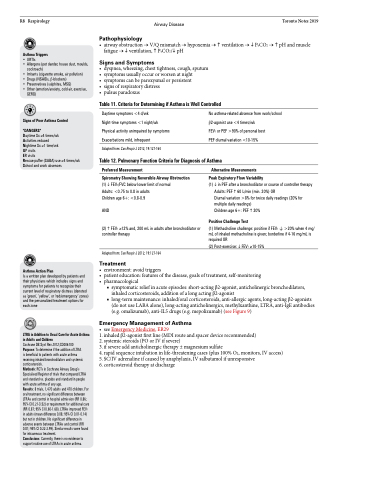Page 1254 - TNFlipTest
P. 1254
R8 Respirology
Asthma Triggers
• URTIs
• Allergens (pet dander, house dust, moulds,
cockroach)
• Irritants (cigarette smoke, air pollution)
• Drugs (NSAIDs, β-blockers)
• Preservatives (sulphites, MSG)
• Other (emotion/anxiety, cold air, exercise,
GERD)
Signs of Poor Asthma Control
"DANGERS"
Daytime Sx ≥4 times/wk
Activities reduced
Nightime Sx ≥1 time/wk
GP visits
ER visits
Rescue puffer (SABA) use ≥4 times/wk School and work absences
Airway Disease Toronto Notes 2019 • airway obstruction → V/Q mismatch → hypoxemia →ventilation →PaCO2 →pH and muscle
fatigue →ventilation,PaCO2/pH
Signs and Symptoms
• dyspnea,wheezing,chesttightness,cough,sputum • symptomsusuallyoccurorworsenatnight
• symptomscanbeparoxysmalorpersistent
• signsofrespiratorydistress
• pulsusparadoxus
Table 11. Criteria for Determining if Asthma is Well Controlled
Pathophysiology
Daytime symptoms <4 d/wk
Night-time symptoms <1 night/wk Physical activity unimpaired by symptoms Exacerbations mild, infrequent
Adapted from: Can Respir J 2012; 19:127-164
No asthma-related absence from work/school β2-agonist use <4 times/wk
FEV1 or PEF >90% of personal best
PEF diurnal variation <10-15%
Table 12. Pulmonary Function Criteria for Diagnosis of Asthma
Preferred Measurement
Spirometry Showing Reversible Airway Obstruction
(1) FEV1/FVC below lower limit of normal Adults: <0.75 to 0.8 in adults
Children age 6+: <0.8-0.9
AND
(2) FEV1 ≥12% and, 200 mL in adults after bronchodilator or controller therapy
Adapted from: Can Respir J 2012; 19:127-164
Treatment
Alternative Measurements
Peak Expiratory Flow Variability
(1) in PEF after a bronchodilator or course of controller therapy Adults: PEF60 L/min (min. 20%) OR
Diurnal variation >8% for twice daily readings (20% for multiple daily readings)
Children age 6+: PEF20%
Positive Challenge Test
(1) Methacholine challenge: positive if FEV1 ↓ >20% when 4 mg/ mL of inhaled methacholine is given; borderline if 4-16 mg/mL is required OR
(2) Post-exercise:FEV1 ≥10-15%
Asthma Action Plan
Is a written plan developed by patients and their physicians which includes signs and symptoms for patients to recognize their current level of respiratory distress (denoted as ‘green’, ‘yellow’, or ‘red/emergency’ zones) and the personalized treatment options for each zone
LTRA in Addition to Usual Care for Acute Asthma in Adults and Children
Cochrane DB Syst Rev 2012;CD006100
Purpose: To determine if the addition of LTRA
is beneficial to patients with acute asthma receiving inhaled bronchodilators and systemic corticosteroids.
Methods: RCTs in Cochrane Airway Group’s Specialised Register of trials that compared LTRA and standard vs. placebo and standard in people with acute asthma of any age.
Results: 8 trials, 1,470 adults and 470 children. For oral treatment, no significant difference between LTRAs and control in hospital admission (RR 0.86; 95% CI 0.21-3.52) or requirement for additional care (RR 0.87; 95% CI 0.60-1.68). LTRAs improved FEV1 in adults (mean difference 0.08; 95% CI 0.01-0.14) but not in children. No significant difference in adverse events between LTRAs and control (RR 0.81; 95% CI 0.22-2.99). Similar results were found for intravenous treatment.
Conclusions: Currently, there is no evidence to support routine use of LTRAs in acute asthma.
• environment:avoidtriggers
• patienteducation:featuresofthedisease,goalsoftreatment,self-monitoring • pharmacological
■ symptomatic relief in acute episodes: short-acting β2-agonist, anticholinergic bronchodilators, inhaled corticosteroids, addition of a long acting β2-agonist
■ long-term maintenance: inhaled/oral corticosteroids, anti-allergic agents, long-acting β2-agonists (do not use LABA alone), long-acting anticholinergics, methylxanthine, LTRA, anti-IgE antibodies (e.g. omalizumab), anti-IL5 drugs (e.g. mepolizumab) (see Figure 9)
Emergency Management of Asthma
• seeEmergencyMedicine,ER29
1. inhaled β2-agonist first line (MDI route and spacer device recommended)
2. systemic steroids (PO or IV if severe)
3. if severe add anticholinergic therapy ± magnesium sulfate
4. rapid sequence intubation in life-threatening cases (plus 100% O2, monitors, IV access) 5. SC/IV adrenaline if caused by anaphylaxis, IV salbutamol if unresponsive
6. corticosteroid therapy at discharge


